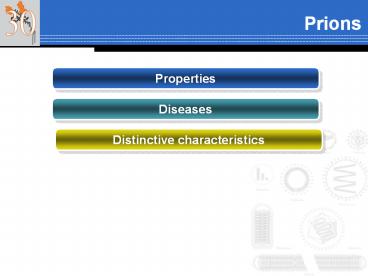Prions - PowerPoint PPT Presentation
Title: Prions
1
Prions
Properties
Diseases
Distinctive characteristics
2
Prions
- Properties
- Small, filterable infectious particles that
contain protein but no detectable nucleic acid. - Prion proteins (PrPC) are encoded by the host
genome. - PrPC is found in neuronal synapses, binds copper,
has unknown function. - Prion proteins become infectious and pathogenic
(PrPSc) as a result of protein conformational
changes. - PrPSc can catalyze its own formation from PrPC in
animals. - PrPSc aggregates and accumulates in diseased
brain.
3
Prions
- Diseases
- Chronic, progressive, invariably fatal central
nervous system degeneration. - Brain pathology is spongiform encephalopathylarge
vacuoles in cortex and cerebellum give brain a
sponge-like appearance. - Affected areas contain microscopic insoluble
amyloid fibrils and macrocrystalline arrays known
as amyloid plaques. - No signs of a host immune response.
- Can arise spontaneously or by ingestion of
infected tissue. - Affects wild and domesticated ruminants (sheep
and goats scrapie cattle mad cow disease)
mink, cats. - Experimentally transferred to mice, hamsters,
chimpanzees.
4
Prions
- Distinctive characteristics
- Proteinaceous infectious agent that contains no
nucleic acid and consists only of a single
species of protein called PrP. - A new kind of infectious agent that can transmit
a disease and replicate itself without the
intervention of informational nucleic acids.
5
Prions
- Prions are proteins that cause fatal brain
diseases - Prion diseases were first detected in domestic
ruminants - BSE, mad cow disease
- Scrapie in sheep, goat
- Human prion diseases can be either inherited or
transmitted
6
Prions
7
Prions
- The infectious agent of prion diseases contains
protein but no detectable nucleic acid - PrPSc is encoded by a host cell gene
Fig. 30.3 Domains and modifications of the prion
protein.
8
Prions
- Differences between PrPC and PrPSc
- Proteinase K treatment of PrPSc gives a
proteinase-resistant 2730 kilodalton core
fragment (PrP 2730) (missing N-terminal aa
23-89) that retains infectivity - PrPSc tends to form oligomers and aggregates
detected as fibrils in infected brains - the conformational change from PrPC to PrPSc
could involve formation of b-helix structure
9
Prions
Top (a) and side views (b), respectively, of PrP
2730 modeled with the N-terminal portion of the
protein as a left-handed bhelix (ribbon arrows
displayed in a triangular barrel). The structure
of the a-helical part (ribbon helices) was
derived from the known strucure of the C-terminal
region of PrPC.
Fig. 30.6 b-helical model of PrP 2730.
10
Prions
- The prion hypothesis formation of infectious and
pathogenic prions from normal PrPC - Preexisting Prpc is required to propagate
infectious prions and cause prin disease
11
Prions
- Is the prion hypothesis correct?
- Pathology and diagnosis of prion diseases
- Tissue abnormalities (insoluble amyloid fifers)
of prion disease are confined to CNS
12
Prions
- Genetics of prion diseases
- Encoded by a single exon of unique gene
- Heterozygosity at 129 protects against both
inherited and infectious prion disease - Prion diseases are not usually transmitted among
different species - Prion infectivity depends on sequence similarity
between donor and recipient prion proteins - But species barrier is not absolute
13
Prions
- Strain variation and crossing of the species
barrier - Human cases of new varient CJD appear to linked
to the BSE epidemic in the UK - New varient CJD is distinct from sporadic CJD,
caused by different prion strain, less restricted
by species barrier - Protein pattern of nvCJD is similar to that of
BSE-infected animals
14
Prions
- The nature of the prion infectious agent
- Prions are transmissible, replicable, and
variable disease-causing agents that are distinct
from viruses. - Whether we define them as living or nonliving
or as an infectious enzyme, we do know the
following about them - (1) they have arisen in organisms during
evolution - (2) they are able to propagate themselves and the
diseases they cause - (3) they appear to be able to evolve and to adapt
themselves to different hosts.
15
(No Transcript)
16
Key Terms
- Mad cow disease
- New variant Creutzfeldt-Jakob disease (nvCJD or
vCJD) - Prion
- Prion disease
- Quinacrine
- Scrapie
- Spongiform encephalopathy
- Transgene
- Amyloid
- BSE
- Chlorpromazine
- Creutzfeldt-Jakob disease (CJD)
- Dendritic cells
- Dura mater
- Kuru





![[PDF] Prions and Mad Cow Disease Full PowerPoint PPT Presentation](https://s3.amazonaws.com/images.powershow.com/10087832.th0.jpg?_=20240729073)

























